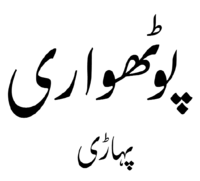| Pahari-Pothwari | |
|---|---|
| پوٹھواری, پہاڑی Poṭhwārī, Pahāṛī | |
 | |
| Native to | Pakistan |
| Region | Pothohar region of Punjab, Azad Kashmir and western parts of Jammu and Kashmir, other parts of India including Punjab and Haryana (by partition refugees and descendants) |
| Ethnicity | Pahari Mirpuri diaspora |
Native speakers | several million[a] |
| Shahmukhi | |
| Language codes | |
| ISO 639-3 | phr |
| Glottolog | paha1251 Pahari Potwari |
Pahari-Pothwari is an Indo-Aryan language variety of Lahnda group,[b] spoken on the Pothohar Plateau in the far north of Punjab, Pakistan, as well as in most of Pakistan-administered Azad Kashmir and in western areas of Indian-administered Jammu and Kashmir, is known by a variety of names, the most common of which are Pahari (English: /pəˈhɑːri/;[1] an ambiguous name also applied to other unrelated languages of India), and Pothwari (or Pothohari).
The language is transitional between Hindko and Standard Punjabi. Pothwari People [2] and is mutually intelligible with both.[3] There have been efforts at cultivation as a literary language,[4] although a local standard has not been established yet.[5] The Shahmukhi script is used to write the language, such as in the works of Punjabi poet Mian Muhammad Bakhsh.
Grierson in his early 20th-century Linguistic Survey of India assigned it to a so-called "Northern cluster" of Lahnda (Western Punjabi), but this classification, as well as the validity of the Lahnda grouping in this case, have been called into question.[6] In a sense both Pothwari, as well as other Lahnda varieties, and Standard Punjabi are "dialects" of a "Greater Punjabi" macrolanguage.[7]
Due to effects of dominant languages in Pakistani media like Urdu, Standard Punjabi and English and religious impact of Arabic and Persian, Pahari-Pothwari like other regional varieties of Pakistan are continuously expanding its vocabulary base with loan words.[8]
Cite error: There are <ref group=lower-alpha> tags or {{efn}} templates on this page, but the references will not show without a {{reflist|group=lower-alpha}} template or {{notelist}} template (see the help page).
- ^ "Pahari". Oxford English Dictionary (Online ed.). Oxford University Press. (Subscription or participating institution membership required.)
- ^ Shackle 1979, pp. 200–201.
- ^ Hussain, Qandeel (2020-12-31). "Punjabi (India and Pakistan) – Language Snapshot". Language Documentation and Description. 19: 144. doi:10.25894/ldd71.
- ^ Masica 1991, p. 440.
- ^ Shackle 1983, p. 183.
- ^ Shackle 1979, p. 201: Pothohari "is often so close to Panjabi that any attempt to maintain the Lahndi scheme ought probably to reckon it as 'Lahndi merging into Panjabi'."
- ^ Rahman, Tariq (1995-01-01). "The Siraiki Movement in Pakistan". Language Problems and Language Planning. 19 (1): 16. doi:10.1075/lplp.19.1.01rah. ISSN 0272-2690.
- ^ Shams, Shammim Ara (2020). "The Impact of Dominant Languages on Regional Languages: A Case Study of English, Urdu and Shina". Pakistan Social Sciences Review. 4 (III): 1092–1106. doi:10.35484/pssr.2020(4-III)79.